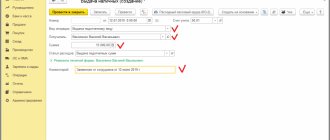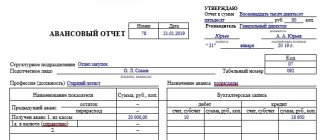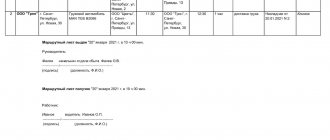The advance travel report in 2021 remains one of the few mandatory travel documents. It is one of the strict reporting documents, and the procedure for filling it out is clearly regulated by the current legislation of the Russian Federation. And since this document is an element of accounting, financial and tax reporting and may be subject to inspection by regulatory authorities, a “free-for-all” approach to filling it out is unacceptable.
- 2 How to fill out an advance report for a business trip
2.1 Photo gallery: sample of filling out an advance report
- 4.1 Features of confirming expenses for a business trip abroad
- 5.1 Photo gallery: posting options for travel expenses
5.2.1 Postings for travel expenses from the example (table)
What is an advance travel report?
An advance report for a business trip is an accounting document that each employee fills out upon returning from a business trip, reflecting all reimbursable expenses incurred in connection with the business trip, and attaches documents confirming these expenses.
This is what an advance report with supporting documents looks like
For the accounting department of the employing company, this document performs two functions at once:
- acts as confirmation of expenses when issuing an advance before the employee leaves on a business trip (and issuing an advance to him is the employer’s obligation, provided for by law);
- serves as the basis for transferring to the employee the funds due to him in the form of compensation for his expenses.
The advance report is also of key importance from the point of view of tax accounting:
- according to Art. 252 and paragraph 1 of Art. 264 of the Tax Code (TC) of the Russian Federation, travel expenses are other expenses in connection with production and sales;
- in accordance with Art. 313 and 314 of the Tax Code of the Russian Federation, these expenses must be confirmed by primary accounting documents, which include the advance report;
- To record expenses according to accounting documentation, you need the date on which these expenses were incurred; according to the law, such a date in relation to business trip expenses is recognized as an advance report.
For the purposes of this chapter, the taxpayer reduces the income received by the amount of expenses incurred <…>. Expenses are recognized as justified and documented expenses <…> made (incurred) by the taxpayer. Justified expenses mean economically justified expenses, the assessment of which is expressed in monetary form. Documented expenses mean expenses supported by documents drawn up in accordance with the legislation of the Russian Federation<…>. Any expenses are recognized as expenses, provided that they are incurred to carry out activities aimed at generating income.
Art. 252 of the Tax Code of the Russian Federation
Until 2015, the package of mandatory travel documents was quite thick. It included, in particular, a travel certificate and a work assignment form with a report on its completion. By 2021, as a result of recent changes in legislation, only an advance report and a business trip order remained mandatory for everyone by law. All others have become optional. If their use is still practiced in the organization and this is reflected in the local act regulating business trips of employees (most often this is a provision on business trips in the organization, but other options are allowed, for example, a set of individual orders), they still need to be issued. And if not, then they are not needed. But in the case of an expense report, the obligation to prepare it is not even discussed.
What is it needed for
An employee’s business trip can have a variety of purposes:
- maintenance, verification of the activities of a branch, remote unit;
- conducting negotiations, concluding contracts;
- procurement of goods, material assets, various services;
- participation in seminars, studies, trainings, etc.
Such activities are financed by the employer, and to confirm the actual expenses incurred, the employee is required to provide a complete financial report to the company’s accounting department. Enclosures (receipts, tickets, paid bills) must be present. Additionally, they can submit for approval a report on the work done, in the form established by the enterprise.
Based on the working report, the company management has the opportunity to analyze the effectiveness of using the funds allocated for the trip. It is immediately checked how the employee coped with the task.
For the employee, the report is a document confirming that he coped with the functions assigned to him, and also did not violate the company’s restrictions regarding expenses during the period of legal absence from the enterprise.
Remember, a business travel report is a supporting document of all of the employee's actual expenses outside the company.
How to fill out an advance report for a business trip
The standard advance report form in form AO-1 (download form) contains a front and back side.
The following information is indicated on the front:
- Full name of the reporting person (sent worker);
- his personnel number (as a rule, this item is filled out by an accountant);
- job title;
- data from the primary document (most often a cash order if the money was issued in cash, or data from a document confirming the transfer of funds to a corporate card), confirming the issuance of an advance. A number of companies practice partial issuance of an advance, so to speak, in kind, when the company, instead of giving an employee, for example, money for travel, purchases a ticket for him. In this case, the ticket is handed to the employee before the trip, and in the advance report it is reflected in the number of documents confirming receipt of the advance (most often this section is filled out by an accountant);
- information about the balance of the previous advance, if applicable (can be completed by an accountant).
The reverse side of the form is dedicated to the actual expenses. Here you need to specify sequentially:
- the date the expense was incurred;
- serial number of the supporting document;
- name of expense;
- amount;
- name of the supporting document.
A separate column is dedicated to each item.
This is what a completed advance report form looks like
Often, both business travelers and some accountants have a misunderstanding about which date to indicate in relation to tickets. After all, it indicates two dates - the date of sale and the day of departure. And tickets are purchased if the employee knew about the business trip in advance, usually in advance. Experienced accountants advise in this case to indicate the date not of the trip, but of the purchase of the ticket, that is, when the expense was actually incurred. The ticket itself is attached to the report as confirmation of the intended use of funds - that the trip took place.
If instead of money for travel, the employee was given a ticket, it is reflected both in the section on the advance payment issued and on the reverse side among the expenses incurred.
In the case of a business trip abroad, the amounts of expenses in rubles and foreign currency are entered in the columns provided for them.
Primary documents confirming expenses are pasted onto a separate A4 sheet, which is then filed with the completed report form. However, most often the business traveler is only required to save and provide all these documents to the accounting department, and then the accountants themselves deal with them.
The algorithm for submitting an advance report is usually as follows:
- Upon returning from a business trip, an employee fills out and signs an advance report, attaches all supporting documents to it and transfers all this to the accounting department.
- The accountant checks the report and signs it, confirming that he accepted it.
- The report is approved by the chief accountant and the first person of the company, putting their signatures in the appropriate columns.
- The employee returns the unspent balance of the advance or receives compensation for overspending.
The scheme can be adjusted depending on the organizational structure of a particular company. After all, in a small business there is often only one full-time accountant, or there may not be one, while the functions of the chief accountant are assigned to the director, who signs for everyone. But the general rule is that the report must be approved by the chief accountant and director, and before signing, it is advisable to have all documentation checked by a professional.
Photo gallery: sample of filling out an advance report
Sample of filling out an advance report for a business trip, front side, part 1
Sample of filling out an advance report for a business trip, front side, part 2
Sample of filling out an advance report for a business trip, reverse side
How travel documents are reflected in accounting
So that accountants can document the costs of business trips and compensation for traveling employees, account 71 “Settlements with accountable persons” is used . In it, the debit of the account shows the amount of money received by the employee, and the credit reflects all the expenses incurred during his business trip.
The unspent part of the advance payment given to the employee before the business trip must be returned to the accounting department upon return, filling out a cash receipt order for this. These travel expenses are included in the reporting documents filled out for the tax office.
If the money issued was not enough and the employee spent his personal funds, the company reimburses him for the costs incurred in excess of the preliminary advance, accompanied by the execution of an expense order.
Postings for expenses in excess of the advance payment issued
| Debit | Credit | Operation name |
| 71 | 50 | Funds issued on account |
| 50 | 71 | Unspent funds were returned to the company's cash register |
| 71 | 50 | The employee was given the amount spent by him in excess of the advance payment issued |
Taking into account the purposes of the business trip, travel expenses are posted in accounting to the appropriate accounts. Expenses for entertainment and cultural events are subject to accounting as non-operating expenses.
When VAT is shown in travel expenses, of which there is documentary evidence with a separate tax line (strict reporting forms, invoice), this VAT is posted to account 19, after which it is sent for deduction (if the specified expenses are such that they reduce the tax component when determining sales tax).
Accounting entries for travel expenses
| Debit | Credit | Operation name |
| 20 (23, 25, 26, 29) | 71 | Travel expenses related to the main activity of the manufacturing enterprise have been written off |
| 44 | 71 | Travel expenses related to the main activity of the trading enterprise have been written off |
| 08 | 71 | Business travel expenses associated with the acquisition of fixed assets have been written off |
| 10 | 71 | Expenses associated with the acquisition of inventories were written off |
| 28 | 71 | Business trip costs associated with the transportation of defective products were written off |
| 91.2 | 71 | Travel expenses related to recreation and cultural and entertainment events |
| 19 | 71 | VAT allocated on travel expenses |
| 68.VAT | 19 | VAT is deductible |
Some expenses of business travelers may not be approved by the employer, and then the employee reimburses these expenses from his own salary (however, it must be taken into account that the amount of such deductions should not exceed 20% of his average earnings) or by depositing cash into a current account or into the organization's cash desk.
| 70 | 71 | Travel expenses not recognized by the employer are withheld from the employee’s salary |
| 50 (51) | 71 | Reimbursement by the employee of expenses not recognized by the employer, to the cash desk or to the current account. |
If the employer independently pays certain expenses by transfer from the company’s bank account (for example, purchasing tickets, hotel reservations), then the following transactions are used:
| Debit | Credit | Operation name |
| 76 | 51 | Business trip expenses were paid from the employer's bank account |
| 20, 23, 25, 26, 29 (44) | 76 | Travel expenses are written off after the employee submits an advance report and is approved by his manager |
| 19 | 76 | VAT allocated on these expenses (if allocated) |
| 68.VAT | 19 | VAT on travel expenses is deductible |
If the employer independently buys a travel ticket for an employee , it is entered into subaccount 3 for the “Cashier” account No. 50, making the following entries:
| Debit | Credit | Operation name |
| 50.3 | 76 | A ticket was purchased for a business traveler |
| 71 | 50.3 | Ticket issued to employee |
| 20, 23, 25, 26, 29 (44) | 71 | Ticket purchase costs written off |
| 68.VAT | 19 | VAT on travel expenses is deductible |
Example of accounting for business trip expenses:
Engineer N.I. Sidorov was seconded for 5 days with the issuance of an accountable amount of 20,000 rubles. His daily allowance is 1000 rubles. Upon return, Sidorov N.I. submits travel documents, that is, an advance report confirmed by expense documents:
- Round-trip railway tickets cost 8,000 rubles, including 1,220 rubles. VAT, where the tax itself is separated into a separate line;
- An invoice from the hotel for 5,000 rubles, drawn up on the appropriate strict reporting form, including 763 rubles. VAT, which is also included in a separate line.
Accounting entries for accounting for business travel expenses:
| Sum | Debit | Credit | Operation name |
| 20 000 | 71 | 50 | Cash issued against cash register |
| 6780 | 20 | 71 | Ticket expenses are written off excluding VAT |
| 1220 | 19 | 71 | VAT allocated on ticket costs |
| 1220 | 68.VAT | 19 | VAT is deductible |
| 4237 | 20 | 71 | Hotel expenses are written off excluding VAT |
| 763 | 19 | 71 | VAT allocated on hotel expenses |
| 763 | 68.VAT | 19 | VAT is deductible |
| 5000 | 20 | 71 | Daily allowance written off |
| 2000 | 50 | 71 | The employee returned the remaining funds to the company's cash desk |
Deadlines for submitting an advance report after a business trip
The employee must submit an advance report within three working days upon returning from a business trip. This is the requirement of the law.
If he does not do this, the employer has the right to recover the entire amount of the advance payment from him through deductions from wages or in court.
In turn, he must issue an order regarding deductions within a month after the deadline for submitting the advance report. However, the amount of such deductions cannot exceed 20% of payments due to the employee. When deductions are made on several items at once (for example, an advance payment for a previous business trip has not yet been fully withheld, for which the same employee also did not report on time), their amount is allowed to be increased to half the salary.
If the employee disagrees with the employer’s decision or the employer missed the one-month deadline for issuing the order, the situation must be resolved only in court.
So doing everything on time is in the interests, first of all, of the employee himself.
Sometimes accountants are tormented by doubts whether there will be problems in light of the fact that the expense report is dated on one date, and expenses on another. But there are no problems with this. Moreover, a business trip usually lasts more than one day, and the employee gets the opportunity to report on it only upon return. However, the same rule also applies to cases when it comes to a one-time expenditure of accountable funds - for example, for the purchase of materials, tools, equipment, etc. If the expenses were incurred on one day, and the advance report was approved within three days after It's no big deal.
The dates [in the supporting document and the expense report] should not be the same. The date on the receipt is when the employee purchased the goods. And the date on the expense report is when he reported the amounts spent to the accounting department. It doesn't have to be one day.
Timur Unarokov, lawyer, Moscow
https://pravoved.ru/question/1277188/
Supporting documents for the advance travel report
To confirm expenses, all financial documents that the employee has in his hands are used and confirm his expenses in connection with the business trip, provided for by law or agreed with management.
For example, if an employee was sent to an industry exhibition, he can purchase product samples there that interest the company - either as part of a job assignment or on his own initiative, having previously agreed on this point and the cost budget with his superiors. It is logical that these expenses should also be reimbursed.
The following documents are used:
- tickets;
- printed forms of electronic tickets (route receipts);
- boarding passes attached to the itinerary receipt of the electronic plane ticket;
- sales receipts;
- strict reporting forms;
- travel certificate, if it is customary for the organization to issue such documents;
- a report on the performance of a job assignment, if its preparation is practiced in the company.
Daily allowances are not subject to separate documentary confirmation, and the travel dates on the basis of which this type of travel expenses are calculated are confirmed in 2021 by tickets or, if the employee traveled to the destination and back by official or personal transport, by travel (route) sheets. But if it is customary for the company itself to issue a travel certificate, which has become optional since 2021, and this procedure is enshrined in its local act, the days of the business trip are counted on the basis of the marks made in it, and it itself is attached to the advance report along with other documents.
Train tickets in 2021 confirm not only travel costs, but also arrival/departure dates
Features of confirming expenses for a business trip abroad
In the case of an overseas business trip, documents are also attached for expenses that must be confirmed in connection with the specifics of such trips, and therefore documents confirming them:
- a receipt for payment of the state fee for the production of a foreign passport, if the employee did not initially have one and he had to issue one in connection with an upcoming business trip;
- confirmation of payment for visa center services;
- receipts or other confirmation of payment of consular and visa fees, including in foreign currency (the procedure for processing such documents is determined by the policy of the consulate of a particular country - funds can be accepted and confirmed in rubles, euros or other currencies, for example, US dollars);
- copies of the first page of the international passport and pages with border crossing marks.
If an employee has a second citizenship, giving him the right to visa-free entry into other countries (for example, he is not only a Russian, but also at the same time a citizen of Lithuania, the Republic of Moldova or Ukraine, who has the right to visa-free entry into the European Union), he attaches copies of all international passports to the report used on the trip. After all, according to the law, he must leave the Russian Federation using a Russian passport.
In legal relations with Russia, its citizens are recognized only as Russians, no matter how many other passports they have, with the exception of countries with which Russia has concluded agreements on dual citizenship, but with the states of the European Union and those whose citizens have the right to visa-free entry into the EU, There are no such people in the Russian Federation. But he has every right to enter other countries using the passport that is more convenient for him. And in this situation, it is also more profitable for the employer, since there is no need to compensate for the cost of a visa. The foreign passport must have a notarized translation into Russian.
The date of border crossing is important when calculating daily allowance. After all, their size most often differs when traveling in Russia and abroad. Moreover, on the way there, daily allowances are calculated according to the norm for another country from the day of entry into it, and on the way back from the day of entry into the Russian Federation - at the domestic Russian rate. For example, if an employee is sent on a business trip to Germany and travels there and back by plane, crossing borders on the day of departure, he is entitled to daily subsistence allowance from the first to the penultimate day of the business trip at the German rate, and for the day of arrival at the Russian rate.
Days of foreign business trip for which daily allowance is due according to the norms for domestic and foreign trips are divided based on the marks in the international passport
If the employee was sent to a country for which an internal passport of the Russian Federation is sufficient to enter, including the Republic of Belarus (after all, as is known, there is no passport control on the border with it), the days of arrival and departure are determined by tickets or other documents that allow establishing the dates of arrival in destination and return to the starting point of the trip.
An important role in confirming expenses for a trip abroad is played by a certificate of currency exchange. This document applies if the employee received an advance in rubles and exchanged them for the currencies of the destination country. If it is attached to the report, all foreign currency expenses are converted into rubles at the rate reflected in it. If there is no certificate, it’s okay, but you will have to calculate it at the rate of the Central Bank of the Russian Federation on the day the report is approved.







